The historic town of Hampi hosts one of the most impressive sites in India. This UNESCO World Heritage Site has ruins from the medieval city of Vijayanangar scattered around an unusual landscape. Hundreds of ancient stone buildings are set between huge granite boulders on small barren hills. There are a few palm trees and some rice fields in the flat spots, but the area is quite dusty and desolate. The landscape that this medieval site was built on adds to its mystique.
In the 14th century a Hindu prince established his capital city in the granite hills near the Tungabhadra River. Over the next 2 centuries Vijayanangar became a major city with huge markets, temples, water tanks, aqueducts and palace buildings. Its importance lasted for 200 years, through four dynasties and grew to have a population of 500,000. The city was very wealthy. There were lavish decorations in the palaces and temples including artwork, precious gems and gold. By the 16th century Vijayanagara was the world’s second-largest city after Beijing, but it all ended when they were conquered by Muslim Sultanates. The gems and gold were stolen, and the city was abandoned; left to crumble.

Terrain in Hampi 
Hampi ruin and giant boulders, Hampi 
Ruins on the Tungabhadra River 
View from Hemakuta Hill, Hampi 
Tungabhadra River, Hampi
Today the area in and around Hampi has hundreds of ruins that demonstrate the grandeur of the city’s history. The Hampi ruins are known for having immaculate carvings on its granite buildings. These carvings can still be seen on the walls, pillars, roofs and even floors of the temples, halls and pavilions which are scattered throughout the boulder-filled hills. The carvings include depictions of Hindu gods, people, mythical creatures and animals such as elephants, horses and crocodiles. The carvings of people include dancers and ones that look like foreigners who may have been trade merchants. There are also a few erotica carvings which always seem out of place in the conservative society of today’s India. Inside, the rooms are filled with tall stone pillars that are also covered in magnificent carvings.

Carving of foreign merchant, Hampi 
Carving of Dancing Woman, Hampi 
Etchings, Hampi 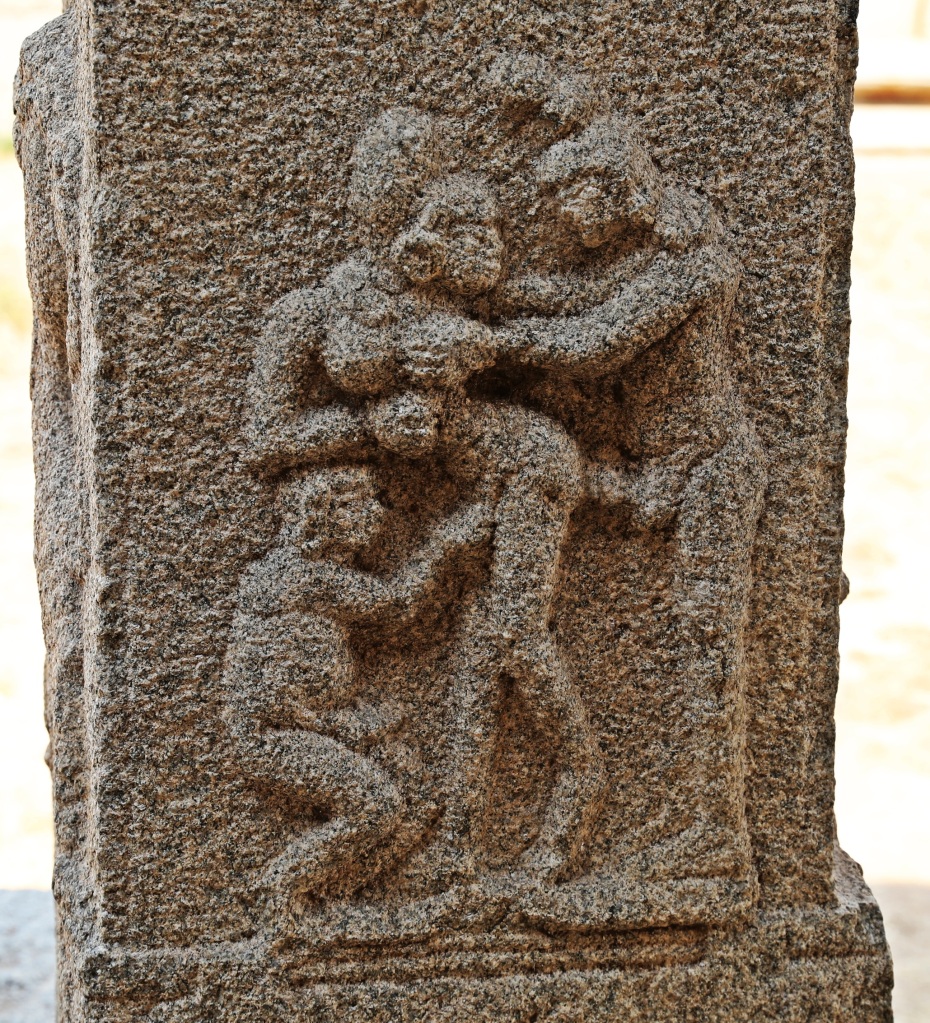
Erotica Carving, Hampi 
Achyutaraya Temple, Hampi 
Carvings. Pavilion at Vittala Temple,Hampi
Virupaksha Temple is one of the oldest structures in Hampi and the only one that is still a functioning Hindu Temple. We learned that if the main deity statue of a temple is damaged, priests will no longer perform pujas and the building is no longer sacred. All other temples in Hampi had damage to their main deity and therefore are not used for worship. Virupaksha Temple has 2 large South-Indian style gopurams or entrance gates. Today, they have been painted a pale yellow. There are many carvings on the temple, the gopurams and the wall surrounding the temple. They are carvings of people, animals, and abstract designs. This temple is similar in construction to the temples that are now in ruins and allowed us to see what they may have looked like in the 14th century. There is a temple elephant named Lakshmi, who grants blessings for donations. We saw her getting her bath at the river one morning. She looked to be loving it!
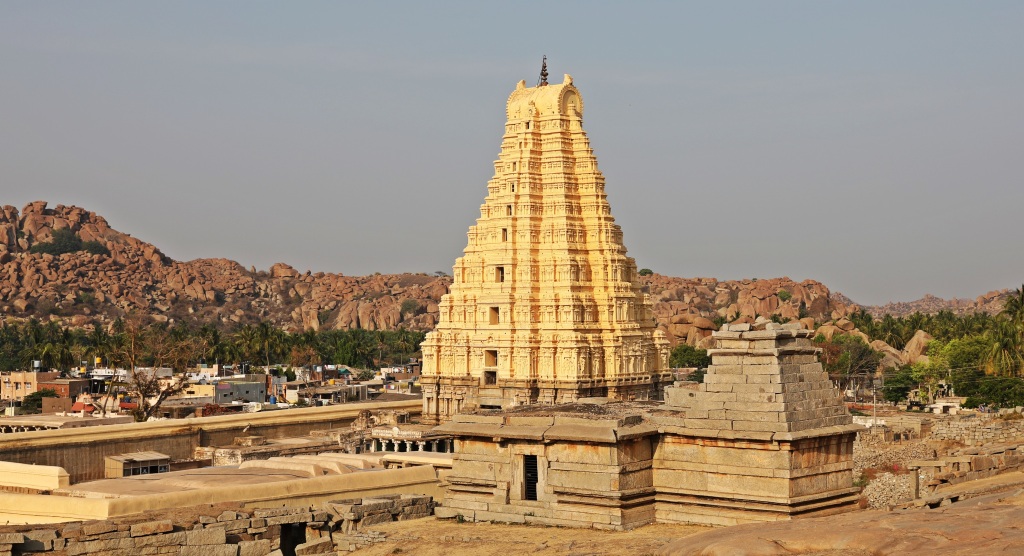
Virupaksha Temple, Hampi 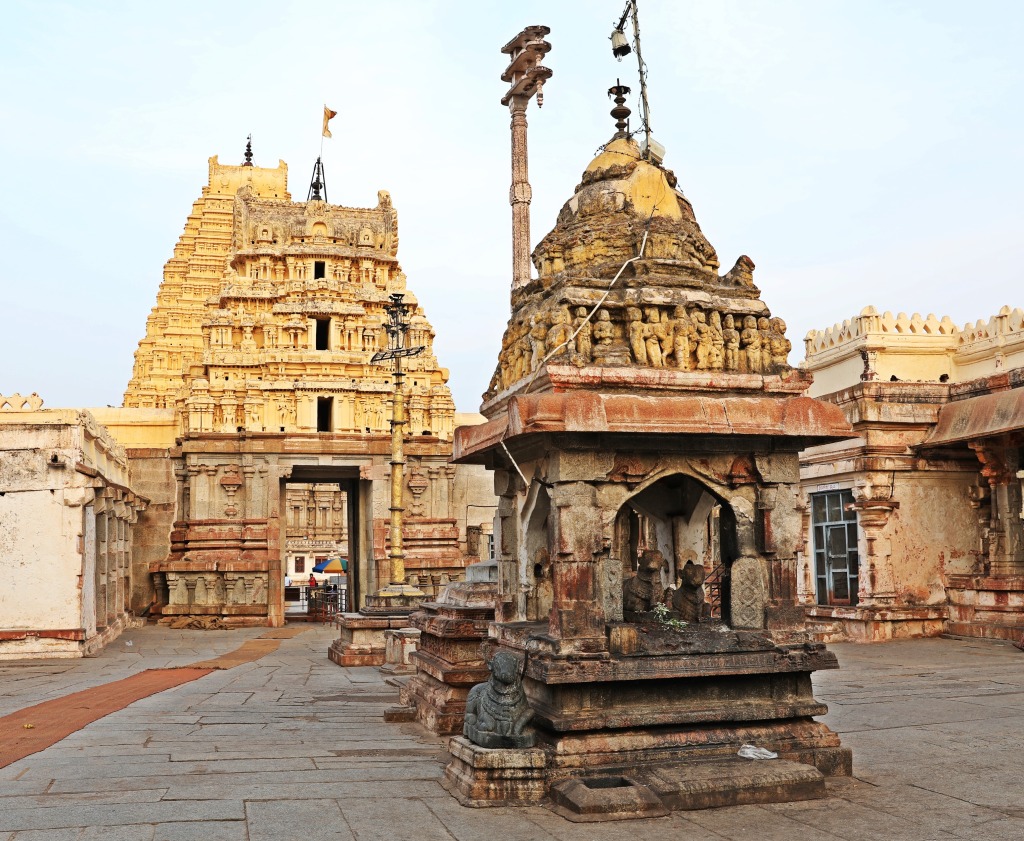
Virupaksha Temple, Hampi 
Carvings, Virupaksha Temple, Hampi 
Lakshmi getting a bath in the Tungabhadra River 
Lakshmi getting a bath in the Tungabhadra River 
Lakshmi spraying herself with water in the Tungabhadra River
Vittala Temple was once a remarkable building with extraordinary design features. Many of the interior columns are monoliths which have been skillfully carved into several smaller columns. It is incredibly beautiful with so much detail. In front of Vittala Temple is the highlight of Hampi. The Stone Chariot is one of the most famous sites in India and is pictured on the 50 Rupee note. There are many elaborate carvings on this ornate structure including mythical characters and flowery designs. At one time the chariot was apparently able to move on the large stone wheels. There are two small stone elephants at the front as if they were ready pull. It is a stunning piece of art. On either side of the chariot are two Pavilions with equally beautiful carvings.

Vittala Temple, Hampi 
Extravagant pillars of Vittala Temple, Hampi 
Stone Chariot, Vittala Pavilion,Hampi 
Stone Chariot, Hampi 
Pavilion, Vittala Temple, Hampi
Another interesting site in Hampi is Hazarama Temple. In this temple the pillars were made of polished black granite. The effect of this dark rock is that the carvings appear even more pronounced. The outside of this temple has many frescoes and inscriptions that depict Ramayana, the story of the life of Hindu God Rama. Nearby, the buildings of Balakrishna Temple have intricately carved gables and roofs.

Hazarama Temple, Hampi 
Black granite columns, Hazarama Temple, Hampi 
Hazarama Temple, Hampi 
Ramayana depected on Hazarama Temple, Hampi 
Roofs of Krishna Temple, Hampi 
Roof of Krishna Temple, Hampi 
Krishna Temple, Hampi
Hemakuta Hill is a spectacular site. The ruins are early, simple buildings but their setting on a granite slab makes the site spectacular. The less visited Achyutaraya Temple has also has a great setting surrounded by palm trees and protected by a rocky hill. The temple and pavilions here also have impressive carvings.

Small temples on granite slab, Hampi 
A Hampi women walking through the ruins 
Ruins on Hemakuta Hill, Hampi 
Interesting roofs on the ruins in Hampi 
Virupaksha Temple, Hampi 
Achuytaraya Temple complex, Hampi 
Achyutaraya Temple, Hampi 
chyutaraya Tempe, Hampi 
Achyutaraya Temple, Hampi 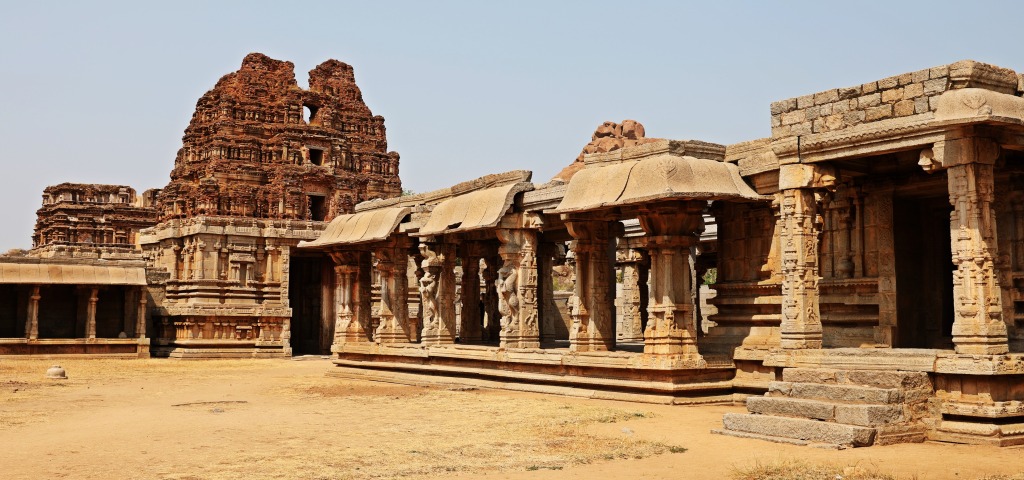
Achyutaraya Temple, Hampi
Hampi has at least four large monoliths. Huge granite boulders were carved into Ganesh, Lakshmi Narasimha (incarnation of the God Vishnu), a Shiva Linga and Nandi the bull. Each is surrounded by a stone building that used to be an active temple, but as each statue has damage, the sites are no longer holy
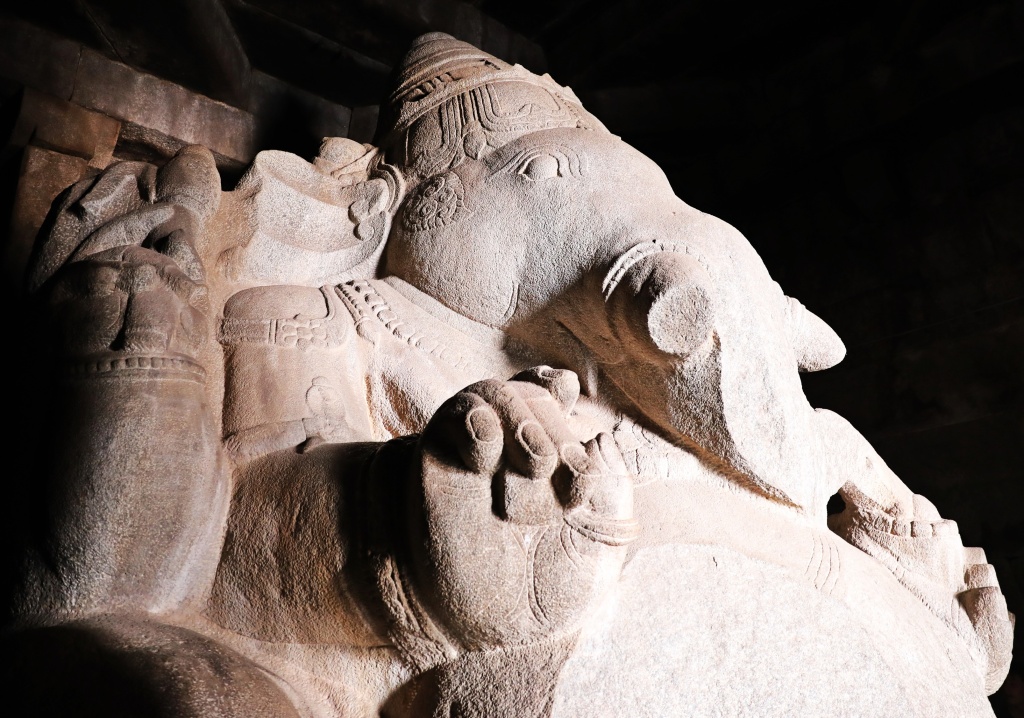
Ganesh monolith, Hampi 
Lakshimi Narasmiha monolith, Hampi 
Lakshimi Narasmiha monolith, Hampi 
Nandi monolith, Hampi
The Queens’s summer palace is different from the other buildings in Hampi. The two-story granite building is called the Lotus Mahal because it was built in the shape of a lotus flower. It has very intricately carved archways and windows. The palace is surrounded by Zenana Enclosure which has five tall watch towers. Behind the garden is the elephant stable. It is one of the most beautiful stables in India. This long building has huge arched doorways and dozens of domes on the roof. There are 11 rooms, one for each of the royal elephants. A little further away is the Queen’s Bath which is an elaborately carved room surrounding a deep water pool.
Water was obviously important for such a large centre. There are many tanks that were either for Hindu rituals or for public usage. Stepped Tank is an impressive black stone pool with multiple steps leading to the water. Its symmetry makes the simple design stunning.

Lotus Mahal, Zenana Enclosure, Hampi 
Watch Tower, Zenana Enclosure, Hampi 
Elephant statue near Elephant Stables, Hampi 
Elephant Stables, Hampi 
Queen’s Bath, Hampi 
Stepped Water Tank, Hampi 
Water tank behind Virupaksha Temple, Hampi 
Hawk on the ruiins, Hampi 
Hoopoe, Hampi
This ancient city of Vijayanagara was a very busy trade centre for everything from fruits and vegetables to valuable gems and gold. Traders would come from far away to sell their wares. As a result, there were quite a few bazaars. Today, what’s left of the bazaars are 2 long rows of stone mandapas where shopkeepers displayed their goods and a large open area in the middle. It’s easy to image these areas filled with merchants and shoppers haggling over goods. There would have been many horse-drawn carts filled with merchandise, either for sale, or already purchased. One of the bazaars was apparently the red-light district. We’re not sure but have an idea what the mandapas were used for at this market! Today town of Hampi is more of a hodge-podge of rundown budget tourist guest houses and restaurants and shabby homes and shops. Nothing compared to the grandeur that was once here.

Hampi Bazaar 
Sule Bazaar, aka red-light district, Hampi 
Krishna Bazaar, Hampi 
Street in Hampi 
Street in Hampi
On a hill on the other side of the Tungabhadra River is Monkey Temple. In Hindu legend, Anjaneya Hill is the birth place of the monkey god Hanuman. Climbing up the 580 steps to the summit in 40° C heat was not enjoyable, but we did see a lot of monkeys on the way. There were dozens of Bonnet macaques in the first 200 steps and then Grey Langers closer to the top. The temple wasn’t much to look at, but from the top we had great, although hazy, views of the Hampi plateau.

Grey Langur monkey 
Monkey Temple, Hampi 
Grey Langur mom and baby 
View from Monkey Temple of Hampi plains 
View from Monkey Temple of rice paddies, palm trees and mountains 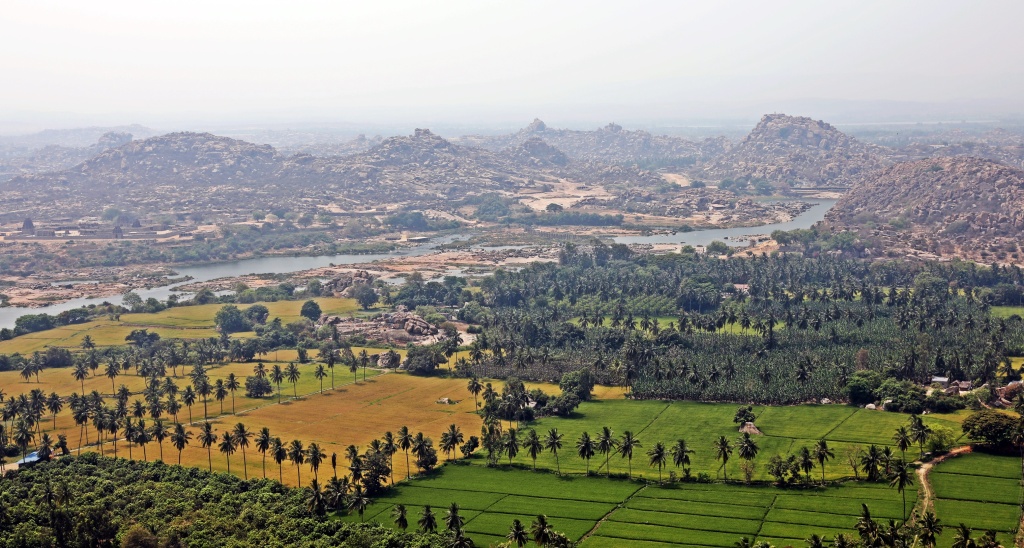
View from Monkey Temple of Hampi plains
Coming up next: Goa – The Portuguese Connection
For extra pics from this trip go to Gallery/Western India. For extra pictures from other blogs go to Gallery at monkeystale.ca
To read about more of our adventures go to Destinations.
If you like what you read, please comment or share it using the links below.
I spent six weeks in India in what seems like a million years ago now and had/ have never heard of this place. The site looks spectacular against its natural backdrop. Some of the carvings are amazing. thank you for sharing. Louise
LikeLiked by 2 people
Hampi is such an incredible place, too bad you missed it.
LikeLiked by 1 person
Next time perhaps. If I do go back to India I will definitely check out your excellent blog as part of our research. Louise
LikeLiked by 2 people
Wow! Those structures are amazing! So intricate! Thanks for sharing. Seems like a fascinating place.
LikeLiked by 2 people
Yes, it’s almost unbelievable how many and how detailed the designs are. Thanks for reading!
LikeLiked by 2 people
I’m starting to realize how much I did not see in India and Sri Lanka. Your photos are certainly giving me the desire to go back!
LikeLiked by 3 people
Thanks! Hampi should be on your next visit!
LikeLiked by 2 people
great… great historical site
LikeLiked by 2 people
It is a gorgeous palace. Thanks for reading!
LikeLiked by 2 people
Another place on my list and I never made it here either. 😦
LikeLiked by 1 person
Hampi is definitely worth a visit, along with Ajanta and Ellora caves. It’s incredible what they created with so few tools?
LikeLiked by 1 person
I agree! We saw petroglyphs in Ulsan (Korea) and I was so amazed.
LikeLiked by 1 person
Another place for my list!
LikeLiked by 1 person
Wow! Looks like a place you could spend days exploring! Very interesting!
LikeLiked by 1 person
Hampi is really incredible. It’s so large and every building has such detailed carvings. You could spend days and not see it all.
LikeLike